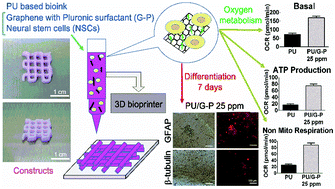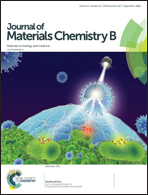A graphene–polyurethane composite hydrogel as a potential bioink for 3D bioprinting and differentiation of neural stem cells†
Abstract
3D bioprinting is known as an additive manufacturing technology that builds customized structures from cells and supporting biocompatible materials for the repair of damaged tissues or organs. In this study, we prepared water-dispersible graphene and graphene oxide, which are 2D nanomaterials with high conductivity and potential applications in neural tissue engineering. Moreover, we synthesized a new biodegradable waterborne polyurethane with soft segments that mostly contained poly(ε-caprolactone) (2 kDa) and 20 mol% of shorter (1.5 kDa) poly(D,L-lactide) chains. This polyurethane dispersion at a solid content of 25% in a cell culture medium underwent a sol–gel transition near human body temperature with a suitable gel modulus. After this, we mixed graphene or graphene oxide with polyurethane to prepare a graphene-based nanocomposite hydrogel for neural stem cell (NSC) printing. The rheological properties of the graphene-based nanocomposite hydrogel were suitable for the printing and survival of NSCs. Furthermore, the addition of a very low content (25 ppm) of graphene nanomaterials to the hydrogel significantly enhanced the oxygen metabolism (2- to 4-fold increase) as well as the neural differentiation of NSCs. In summary, the graphene–polyurethane nanocomposite hydrogel may be a possible bioink for printing 3D cell-laden tissue constructs for neural tissue engineering.



 Please wait while we load your content...
Please wait while we load your content...